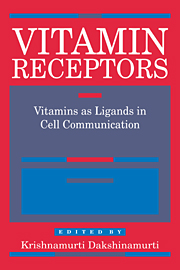Book contents
- Frontmatter
- Contents
- List of contributors
- Preface
- Introduction
- 1 Serum and cellular retinoid-binding proteins
- 2 Retinoic acid receptors
- 3 Vitamin D receptors and the mechanism of action of 1,25-dihydroxyvitamin D3
- 4 Cobalamin binding proteins and their receptors
- 5 Folate binding proteins
- 6 Riboflavin carrier protein in reproduction
- 7 Binding proteins for α-tocopherol, L-ascorbic acid, thiamine amd vitamin B6
- 8 Biotin-binding proteins
- List of abbreviations
- Index
Preface
Published online by Cambridge University Press: 06 January 2010
- Frontmatter
- Contents
- List of contributors
- Preface
- Introduction
- 1 Serum and cellular retinoid-binding proteins
- 2 Retinoic acid receptors
- 3 Vitamin D receptors and the mechanism of action of 1,25-dihydroxyvitamin D3
- 4 Cobalamin binding proteins and their receptors
- 5 Folate binding proteins
- 6 Riboflavin carrier protein in reproduction
- 7 Binding proteins for α-tocopherol, L-ascorbic acid, thiamine amd vitamin B6
- 8 Biotin-binding proteins
- List of abbreviations
- Index
Summary
Contemporary research has allowed us to discern a linguistic structure in biological interactions in which molecules in solution and in or on membranes react with one another, sequentially, and thus form sentences of a language. Interlocking ligand–receptor systems constitute an intracellular and intercellular communication system in which molecules, such as cytokines, hormones, metabolic products, vitamins and foreign macromolecules can serve as words and convey signals – messages – through combination with membrane structures, i.e. receptors. These signals can initiate synthesis of other factors which can combine with receptors and form the sentences of the molecular language. Thus, molecular language consists of sequential interactions between receptors and ligands, which are either cell-bound or secreted by one cell and taken up by membrane structures of another cell. A succession of these interactions at the membranes of cells and organelles coordinate cell metabolism within the same and between different cells and organs.
The analogy between language and molecular communication can also be detected in the evolutionary diversification of words, i.e. in the existence of superfamilies of molecules, having a common two-chain structure and involved in recognition of different ligands. Members of these families show homologies in a variety of cell types and among cells of different animals, from invertebrates to vertebrates.
Within cells, some types of organelles acquire macromolecules from the cytoplasm. The site-specificity of these acquisitions depends on receptors, which recognize appropriate proteins by signals that may consist of amino acid sequences or of post-translational modifications.
- Type
- Chapter
- Information
- Vitamin ReceptorsVitamins as Ligands in Cell Communication - Metabolic Indicators, pp. xi - xivPublisher: Cambridge University PressPrint publication year: 1994

